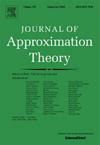The molecular characterizations of variable Triebel–Lizorkin spaces associated with the Hermite operator and its applications
IF 0.6
3区 数学
Q2 MATHEMATICS
引用次数: 0
Abstract
In this article, we introduce inhomogeneous variable Triebel–Lizorkin spaces, , associated with the Hermite operator , where is the Laplace operator on , and mainly establish the molecular characterization of these spaces. As applications, we obtain some regularity results to fractional Hermite equations where , and the boundedness of spectral multiplier associated to the operator on the variable Triebel–Lizorkin space . Furthermore, we explain the relationship between and the variable Triebel–Lizorkin spaces (introduced in Diening et al. (2009).) via the atomic decomposition.
与Hermite算子相关的变量triiebel - lizorkin空间的分子表征及其应用
本文引入了非齐次变量triiebel - lizorkin空间Fp(⋅),q(⋅)α(⋅),H(Rn),并结合Hermite算子H(Δ+|x|2),其中Δ为Rn上的拉普拉斯算子,建立了这些空间的分子表征。作为应用,我们得到了分数阶Hermite方程(−Δ+|x|2)σu=f,(−Δ+|x|2+I)σu=f的一些正则性结果,其中σ∈(0,∞),以及变量triiebel - lizorkin空间Fp(⋅),q(⋅)α(⋅),H(Rn)上与算子H相关的谱乘子的有界性。此外,我们通过原子分解解释了Fp(⋅)、q(⋅)α(⋅)、H(Rn)与变量triiebel - lizorkin空间Fp(⋅)、q(⋅)α(⋅)(Rn) (Diening et al.(2009)引入)之间的关系。
本文章由计算机程序翻译,如有差异,请以英文原文为准。
求助全文
约1分钟内获得全文
求助全文
来源期刊
CiteScore
1.90
自引率
11.10%
发文量
55
审稿时长
6-12 weeks
期刊介绍:
The Journal of Approximation Theory is devoted to advances in pure and applied approximation theory and related areas. These areas include, among others:
• Classical approximation
• Abstract approximation
• Constructive approximation
• Degree of approximation
• Fourier expansions
• Interpolation of operators
• General orthogonal systems
• Interpolation and quadratures
• Multivariate approximation
• Orthogonal polynomials
• Padé approximation
• Rational approximation
• Spline functions of one and several variables
• Approximation by radial basis functions in Euclidean spaces, on spheres, and on more general manifolds
• Special functions with strong connections to classical harmonic analysis, orthogonal polynomial, and approximation theory (as opposed to combinatorics, number theory, representation theory, generating functions, formal theory, and so forth)
• Approximation theoretic aspects of real or complex function theory, function theory, difference or differential equations, function spaces, or harmonic analysis
• Wavelet Theory and its applications in signal and image processing, and in differential equations with special emphasis on connections between wavelet theory and elements of approximation theory (such as approximation orders, Besov and Sobolev spaces, and so forth)
• Gabor (Weyl-Heisenberg) expansions and sampling theory.

 求助内容:
求助内容: 应助结果提醒方式:
应助结果提醒方式:


